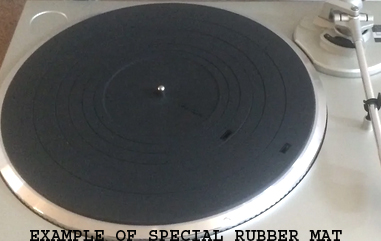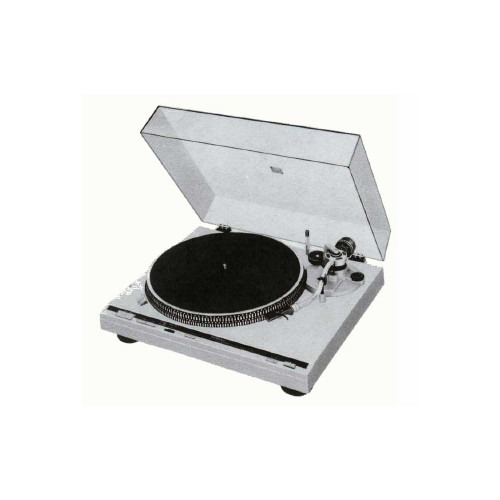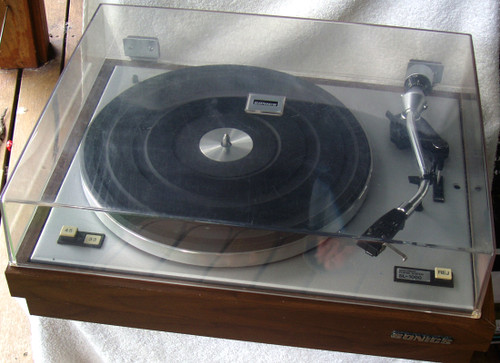Here is a very nice, entry level to mid range fully automatic turntable from Technics....if you like such things (automatic turntables)! Let me explain my thinking a bit more.
I have nothing against Technics but in our audio post production work we only used the venerable SP10's, a lovely turntable for our purposes. Lovely in that it is solid, heavy metal based and without fancy operator "bells & whistles" - that is how I like my turntable. KISS (Keep It Simple Stupid) principle always wins in the end!
Over time we "played around" with other turntables, purely from a technical view, and bought this SL-Q300. This is a fully automatic turntable, even detecting the record size placed on the platter (urghhhh ... why oh why?) but it was fun to play with and then away it went into the backroom, never to be used again!
Nice turntable with a good name but all those bells and whistles just didn't cut it for us ... I talk more about that further down in the description.
Funny enough, I have left the beautiful Micro-Acoustics Corp (USA) cartridge in place, this is actually a real gem and worth more than the turntable!
For the average consumer, having a nice Technics turntable is certainly something to be proud of, and a great starting point to enter the amazing world of ANALOG vinyl music.
TECHNICS Fully Automatic Turntable
Designed & Made in Japan
1983 ~ 1985
33 & 45 RPM ONLY
Model: SL-Q300
Australian with standard Australian power lead
COMPLETE WITH:
Perspex hinged dust cover
Micro-Acoustics Corporation (Stratus series) S1 cartridge
50 PE Stylus *** See notes below
FELT Technics special mat - NOT rubber *** See notes below about this
Scanned but printed User Manual (very useful to understand how the auto features work!)
2 channel RCA male to RCA male audio lead (detachable rear connection)
Australian power lead (figure 8 female plug to 2 pin Australian GPO plug - no earth)
TECHNICAL FEATURES:
Quartz crystal speed control
Electronic visual strobe confirms speed locking
Direct Drive - no belts to replace!
Automatic detection of 7" or 12" records if desired or manual overide
Aluminium alloy platter
Wow & Flutter maximum 0.025%
Rumble: -78dB
Tonearm (metal) is a straight arm with static balance
Effective length 230mm
Overhang 15mm
Dimensions: 430mm x 110mm x 375mm (110mm height includes the dust cover hinged lid)
Weight: 4.5Kg
SPECIAL NOTES:
CARTRIDGE:
Micro-Acoustics Corporation (USA) Stratus series S1 cartridge is fitted, these are difficult to find now but definitely a "cut above" the usual Audio Technica cartridges to be found on these types of turntables.
Technology: Moving Magnet
1981 era
Frequency response: 5Hz ~ 20Khz +/- 1.6dB
Tracking force: 0.9g ~ 1.6g
Transient ability (rise time) 8uS
Output voltage: 3.5mV
Channel separation: 30dB (1kHz) 20dB (10Khz)
Cable capacitance is not critical: 25pF ~ 1500pF
Load resistance is also not critical: 5K ~ 100K Ohms
Cartridge weight: 4.25g
The above information is taken directly from the information data sheet/care of your cartridge sheets which can be supplied if the new owner wishes (hard copy)
The supplied cartridge DOES HAVE the stylus fitted. It is NOT new but upon close visual inspection with a microscope, the tip appears to be fine at the moment although I have no records of how many hours it has been running around in the grooves. We always kept records of styli useage but as this was not one of our "workhorses" no records appear to have been kept by the sound engineer.
I ALWAYS suggest obtaining a brand new stylus as soon as possible, so that you can keep an accurate account of how many hours it has been used. These stylus should only be used for 400 ~ 500 hours before replacing. To continue using a worn stylus is putting your valuable vinyl collection at risk - imagine running a blunt nail around those grooves! That is an extreme example of what you would be doing with a worn stylus.
Ok, all well and good but can you get a 40 year old stylus?
The stylus fitted is the original, not a faus stylus, type number 50 PE
The stylus is 0.25 x 0.7 mil elliptical shape
I know you can also use a 572-DE stylus, actually the same stylus fits the whole S1 ~ S3 series of cartridges from Stratus.
Yes these are a bit tough to find but YOU CAN BUY REPLACEMENT STYLUS (NOT FAKES) but sit down when you look at the prices, like all GOOD styli, they are not low cost these days.
I have found replacement 50 PE's and 572-DE's ranging in price from USD$187 up to USD$237 HERE IS A LINK TO JUST ONE SUPPLIER
MAT:
The supplied mat is one of the special mats you should use with these turntables. Why special? Because the vinyl record diameter detection uses a couple of physical 'fingers' fitted onto the platter. These fingers protrude slightly upwards which means the mat MUST have two rectangular cut-outs for these fingers. Of course you could just drop an ordinary mat onto the platter (no auto record size detection then) but then you have created a "bump" in the mat because the detection system of the platter is slightly raised and then your tonearm/cartridge/stylus has to deal with bump every time it plays a record - it is far better to use the correct mat in the first place.
The only mat I could find with this turntable is the felt mat - not rubber. What's worse, someone has decided to cut around the centre spindle area! Now this is not as bad as it might seem, as long as those two rectangular slots are fitted onto the platter fingers, all is well with the world!
I personally don't like felt mat's that much so it would be a good idea to get a nice genuine Technics SL-Q300 mat, here is a picture of what they look like and I have seen a few around online - most people don't even seem to know why they have the slots cut into them!

Oh and some might think "just dump the old platter" and fit one without the fingers - this will NOT work! These platters have magnets all around the centre area, this is part of the servo motor and if you fit an ordinary diecast platter without these magnets then it will not move one millimetre!
COSMETIC CONDITION:
After 40 years, there are some minor blemishes but nothing surprising or dramatic.
All rubber base feet are in great condition, not spongy - great acoustic isolation
Plastic casing is undamaged and without scratching
Front panel user buttons/slide switches are in average condition, light oxidisation can be seen
Strobe window is clean and clear
Diecast aluminium platter has edge "aluminium rot" or oxidisation. It's a funny thing, I see this all the time with old Technics turntables, even our SP10's were showing this problem. Not sure what to call it, it is like black lines on the aluminium surface. If it was oxidisation, I would have expected white marks showing. We found in the past that a good rub up with metal polish often greatly reduced this visual problem. It's all a visual thing and in no way affects the operation of the turntable.
Tonearm assembly is undamaged and clean, as is the tonearm rest post with lock
Dust cover hinges work well, lift up the lid and it stays there!
Sad though about the dust cover, another common problem area on turntables. This one is no exception with a slight fogginess to the acrylic and a number of light scratches on the top. There is also one side crack down the front centre area. So the dust cover is not the best looking but it does the job of keeping out dirt/dust and with a good hunt around it shouldn't be too difficult to find a better looking dust cover - I have seen other SL series turntables (not just the Q300) using the same dust cover.
Felt mat (as mentioned above) has had someone hacking the centre spindle area. Normally this would make the mat useless but because it has those two rectangular cut-outs for the record diameter detection, it does stay in place properly but it would be a good idea to dump this felt mat and get a proper rubber Technics mat sometime in the future.
TESTING:
The turntable has been sitting in my storage units for a long long time, I closed down our business activities 10+ years ago! After all this time, my wife has suggested that all this gear finds new homes - so out it goes, but first I checked it out.
First up, because it has not been in use for so long I took a look inside/underneath and sure enough, the grease had gone pretty hard. I cleaned up the old grease, re-lubricated all friction points that need it and also a couple of drops of special turntable oil to the centre spindle.
Ok, it's truth telling time ... power up time.
I first ran the turntable in MANUAL mode (raise the arm using the front panel button) and physically move the arm towards the platter.
Platter spins up and very quickly locks onto the correct selected rotational speed. I then loaded the platter with high torque (my hand!) and then watched how fast it "got back up to speed" - very very fast, the speed control and feedback circuits all work great!
Strobo light is bright and easy to read and it should be noted this is LED based, not neon (like the old SP10's) - those neon's fail eventually and the LED is much brighter too.
There is no user "fine speed adjustment" it just locks quickly onto 45 or 33rpm
I checked for any audible bearing noise - none at all could be heard.
I also checked the static pivot for excessive play - all good here.
Adjusted the stylus force adjustment on the side of the counter-weight (thumb screw at the rear of the counterweight) and set it for 1.25g
Very carefully checked the lovely S1 cartridge and the stylus tip - looking good.
Next, I played a standard 12" vinyl (manually) making sure that once the run-out was reached, it returned smoothly to the tonearm rest - all good here too, the mechanical movement of the arm is very smooth as is the "up - down" of the tone-arm, a nice gentle drop onto the vinyl!
Ok, time to play around with this "dicky" auto record size detection....
If the tonearm is not raised with the front panel button, the turntable operates in automatic mode. This means, you place your record on the platter (7" or 12") and then just push START.
The tonearm moves across to the record run-in area, drops gently onto the record and plays. Once the record reaches the run-out, up comes the tonearm and it returns to rest UNLESS you have pushed the REPEAT button, in which case the tonearm will go back to the run-in area and start playing from the beginning all over again and again and again ....
If for some reason you want or need to adjust where the run-in and run-out areas are detected, this is an easy "user adjustment" and is explained in the manual.
You CANNOT use this automatic function with a 10" record, the sensor will not understand what you have placed on the platter and on automatic mode, the tonearm will move to the platter, stop (BEFORE lowering the tonearm) and after a second or so, goes back to the tonearm rest. The same applies if you forgot to put your record on the platter!
All this does not mean you cannot play 10" records, you just go into MANUAL mode (see above) and all is well with the world, you can play anything because YOU are in control, not the dicky Technics system.
One type of record you can forget about playing is the special DJ releases that are "back to front" (yes, I have had some of those beasties) because they START (the run-in area) at the centre of the record and go outwards towards the rim - weird huh! and very difficult to play unless your turntable is completely manual (no auto return to the tonearm rest)
SUMMARY:
Nice "hi tech" Technics turntable, with an even nicer cartridge - all ready to go and give listening pleasure at a new home.
















